Why study Kronebreen and other small glaciers?
There are two motivations behind writing this blog post. One is to document the deployment of our time-lapse cameras for a third consecutive summer season at Kronebreen, which is a fast-flowing tidewater glacier in Svalbard. It is difficult to justify such intensive fieldwork without explaining why we are doing this research though. So the second reason for writing this is to explain why we are studying Kronebreen, and more importantly why findings from smaller glacier systems are just as significant as those from bigger catchments (i.e. Greenland and Antarctica). The take home message from this is that the study of smaller glaciers is essential to progressing our understanding of glacier dynamics which ultimately feeds into better prediction of future sea level rise.
DISCLAIMER: All opinions are my own and I encourage discussion on the subject matter. I'm all ears!
About Kronebreen and our research
Kronebreen is a heavily crevassed, elongated glacier located in Svalbard, the Arctic archipelago that is situated to the north of Norway. The glacier flows from an expansive ice field to a fjord called Kongsfjorden, which is connected to the Atlantic Ocean. The name Kronebreen literally translates to "crown glacier", Kongsfjorden means "king's fjord", and a lot of the other glaciers in the area are named along this theme - for example, the two neighbouring glaciers to Kronebreen are Kongsbreen (to the north) and Kongsvegen (to the south) which mean "king's glacier" and "king's road".
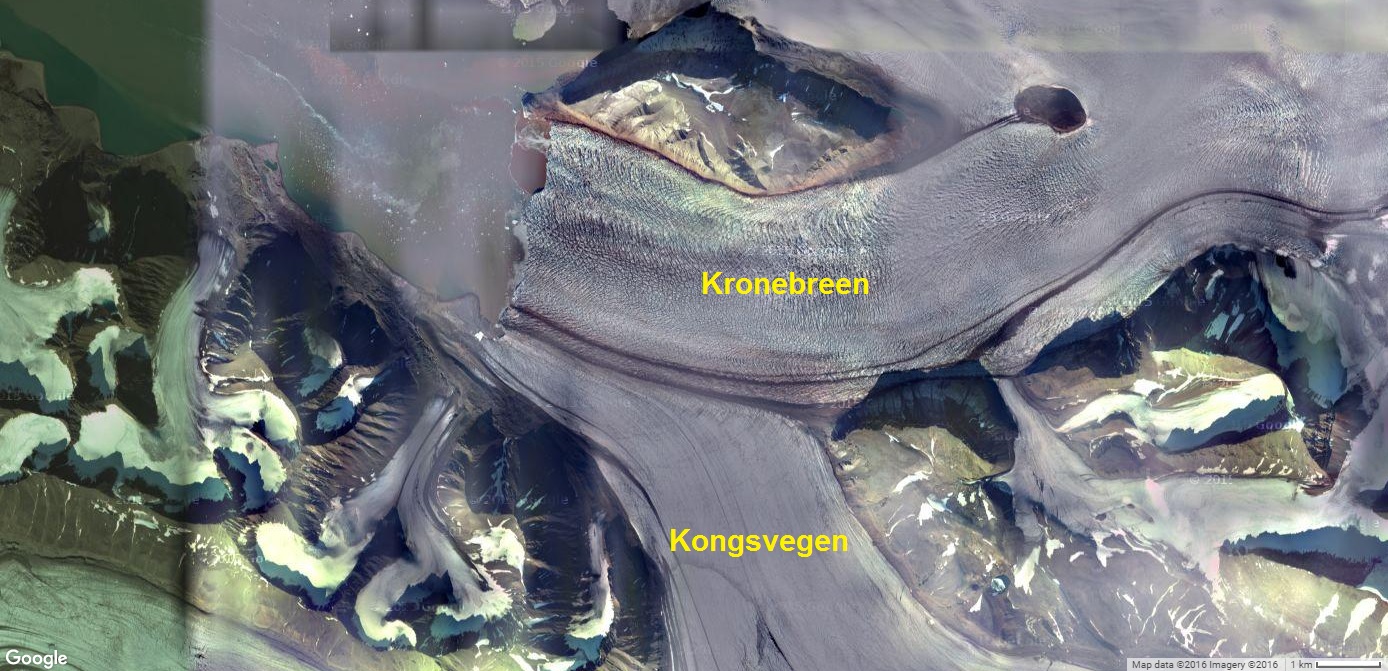 </a>
</a>
Satellite imagery of Kronebreen and Kongsvegen in 2011. Where their margins converge is signified by a significant dark debris band. Note how Kronebreen is much more crevassed than Kongsvegen (to see this contrast in better detail click here). Source: Google Earth.
Where the front of Kronebreen meets the fjord water, a process called calving occurs. Calving is the mechanism by which ice detaches to form isolated icebergs. Calving was once considered a minor component of glacier dynamics, but is now understood to form a significant contribution to future sea level change. There are still many uncertainties concerning when and how calving at tidewater glaciers will occur in the future though, which makes it difficult to accurately predict future sea level change.
There are certain controls on calving which dictate the size of each ice piece that breaks off, and the frequency at which these events occur. Calving activity at Kronebreen is generally characterised as frequent and small (in comparison to larger glacier systems such as those found in Greenland and Antarctica). Calving has increased gradually year-on-year at Kronebreen, and the front has been retreating since the early 1900s (Nuth et al., 2012). Recent work has confidently linked this to warming of the Atlantic Ocean - Kronebreen and other glaciers in the Kongsfjorden are particularly susceptible because they are positioned close to a strong current of water (the West-Spitsbergen Current) which brings warm water from the south to the interior Arctic (Luckman et al., 2015).
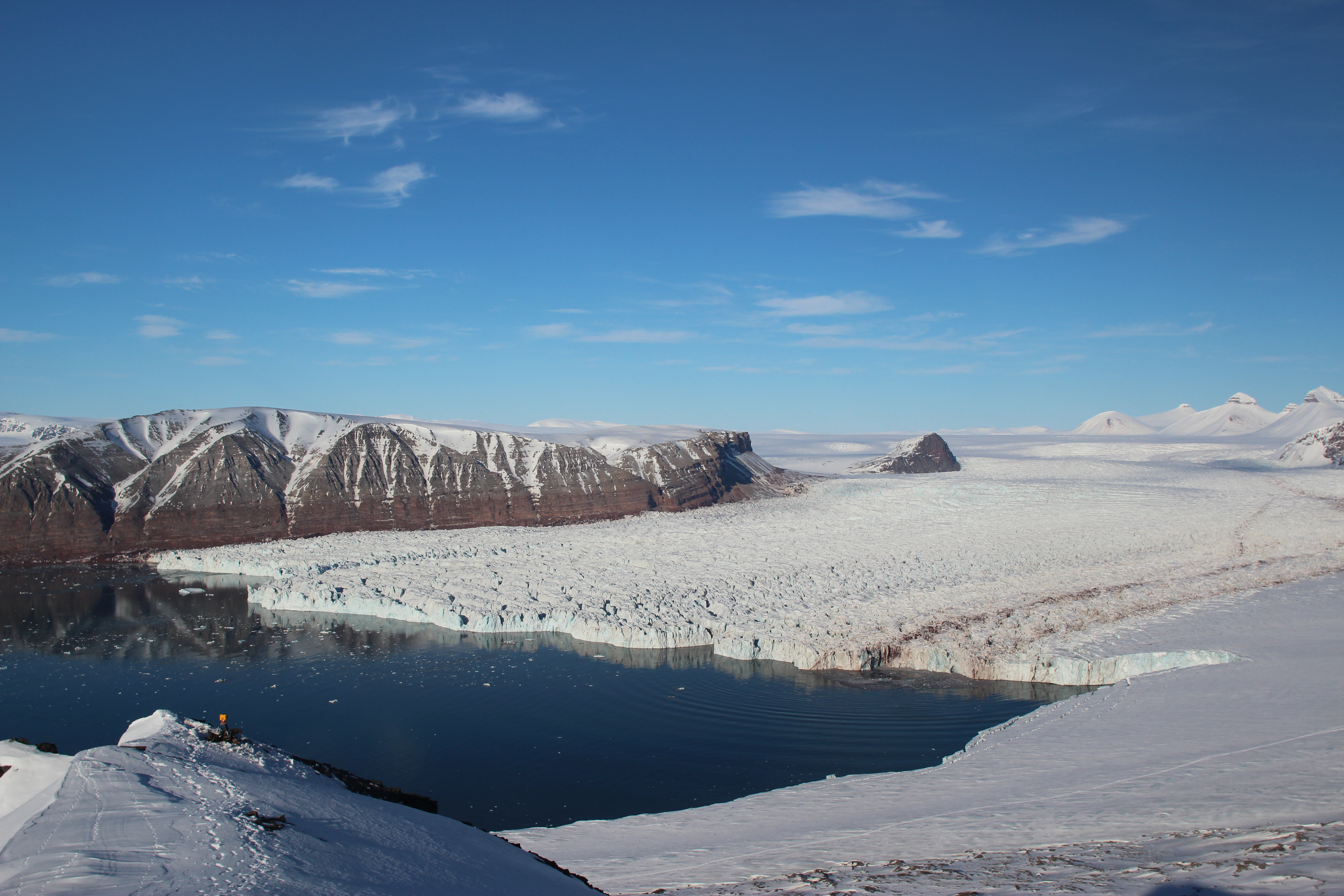
One of our time-lapse cameras (the tiny yellow dot) looking at the front of Kronebreen and Kongsvegen glaciers.
We have been placing time-lapse cameras at Kronebreen for the past 3 years to monitor its calving activity and terminus position, along with its velocity and the presence of lakes on the glacier surface. We previously chose camera locations which produced images that adequately covered the entire glacier surface. This year we have placed our cameras much closer together, focusing on the first kilometre of the glacier front. The reasoning behind this re-shuffle is to ensure adequate overlap in the images from each camera, which we can use to attempt three-dimensional time-lapse. Using a technique called Structure-from-Motion, images taken from multiple angles can be used to form a three-dimensional model of a given object. In this case, we will produce Digital Elevation Models (DEMs), potentially every half an hour. This will give us a highly detailed look at how the front of Kronebreen changes over the summer season.
Myself and my supervisor spent a week in Svalbard at the end of April installing our cameras, alongside researchers from Norsk Polarinstitutt who are looking more generally at changes in the Kongsfjorden area. The fieldwork was very successful and we installed 10 time-lapse cameras in total - 8 were installed at Kronebreen, and 2 were positioned at Kongsvegen and Kongsbreen. The weather was our main constraint, meaning we had to squeeze 7 of these installations into one day which took nearly 14 hours. Luckily, Svalbard is in 24-hour daylight at this time of year, which allowed us to work such long hours.
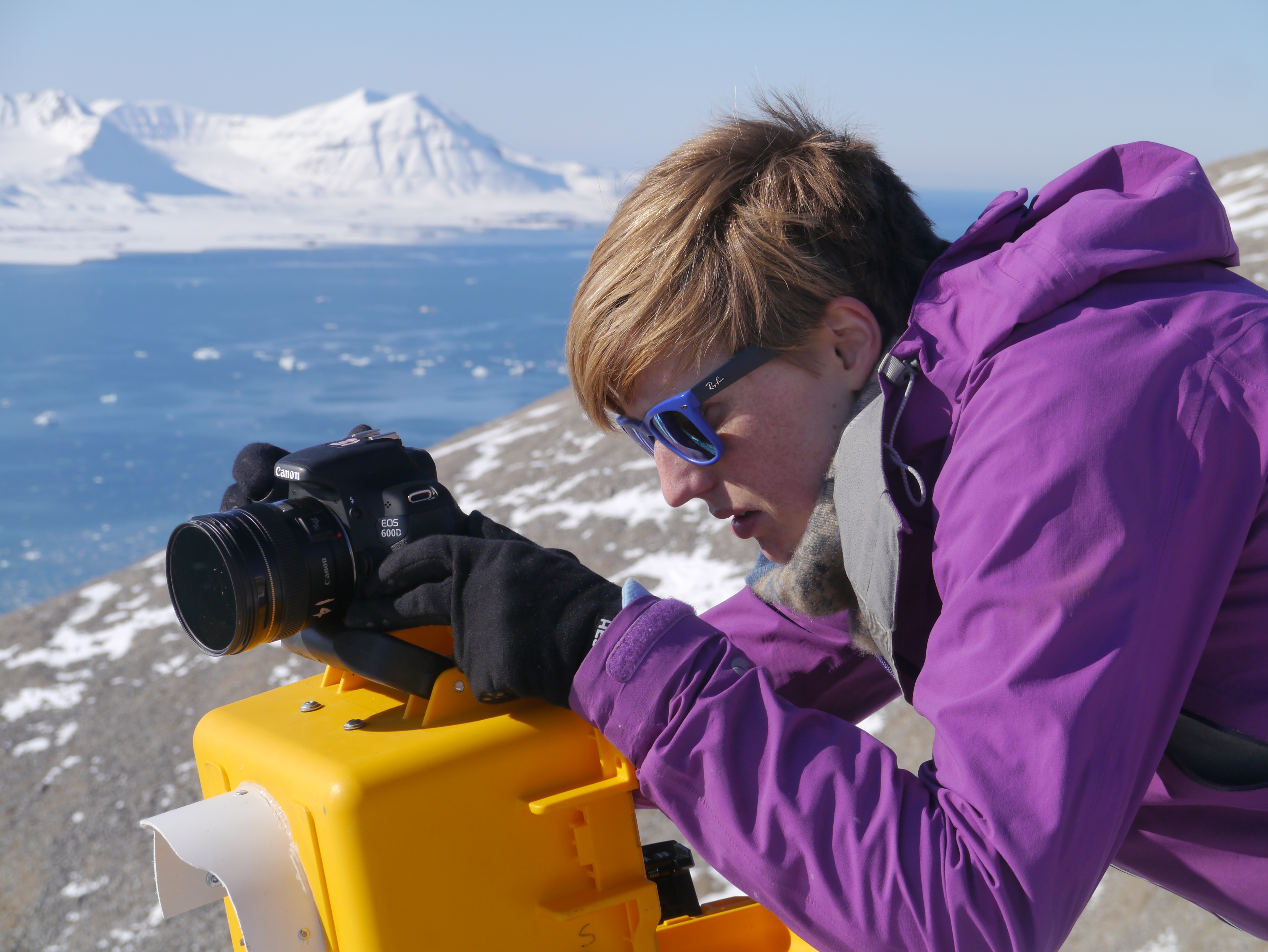
Lining up one of our time-lapse camera systems. To generate three-dimensional time-lapse sequences, we had to be very specific about each camera placement and exactly where each camera pointed. Because of this, we dedicated a day to scouting out new sites and generating test photos which we used to produce demo Digital Elevation Models.
Why Kronebreen?
In my opinion, one of the biggest misconceptions in glaciology is that research on Greenland and Antarctica (i.e. 'larger' glacier systems) is more important than research on smaller glaciers. This is generally because the Greenland and Antarctica ice sheets are the largest contributors to future sea level rise. And yes, in a direct sense this is true, they are extremely important to study. Greenland and Antarctica hold 99% of the world's freshwater ice and if that all vanished, sea level would rise by approximately 65 metres (IPCC, 2013). Often research on Greenland and Antarctica is published in higher-impact journals because of the direct importance of the findings. Research on smaller glaciers is just as important though, as the findings can have significant implications for larger glacier systems. It is just harder to convey this because the findings are usually limited to indirect implications.

A big, catastrophic calving event at Helheim glacier, East Greenland, captured by a group of researchers at Swansea University in 2010. The calving event here is approximately 4 km long and the height of the ice cliff above the waterline is 100 metres. Such big calving events like this rarely occur and thus are often not observed or captured. The full video of the calving event can be viewed here. Associated research papers from this work are listed at the end of this article.
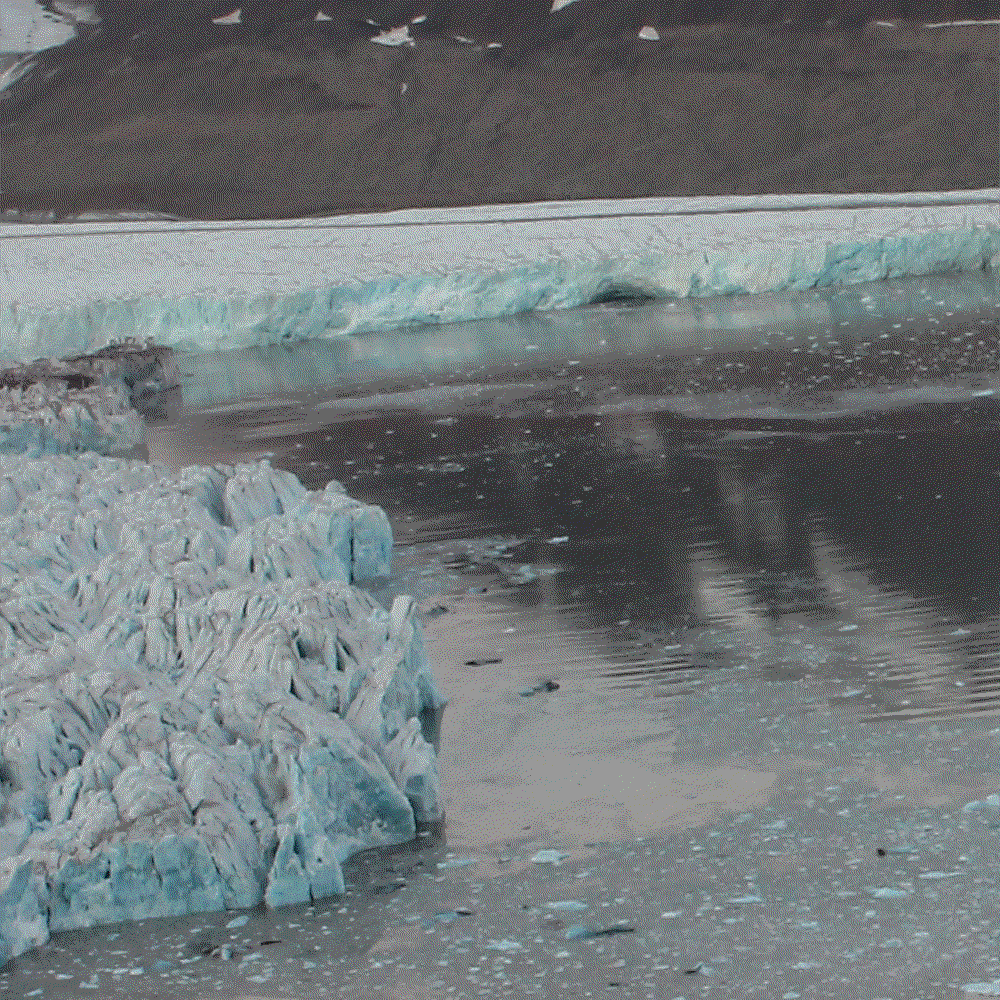
In contrast, a small calving event at Kronebreen, Svalbard. The calving event here is approximately 50 metres high and spans 50 metres of the glacier front. Such events occur frequently at Kronebreen (approx. 1 every hour) and this is similarly observed at other smaller glaciers.
Research on calving dynamics is a good example where studies have largely focused on Greenland and Antarctica (so far). Calving activity at Greenland and Antarctic mainly consists of rare, catastrophic events, such as calving across the entire ice cliff or complete collapse of an ice shelf (e.g. Larsen B Ice Shelf, Antarctica). Obviously, these types of events have a significant impact on future glacier dynamics and sea level change. Studies have largely focused on understanding this type of calving. This trend may be because this research is still largely in its infancy. The idea that oceans interact with glacier fronts was not considered particularly important until fairly recently (Straneo et al., 2010).
At the other end of the spectrum though, calving events can also be small and frequent. This type of calving has not been as thoroughly studied as larger calving styles so far. Small calving styles are often observed at smaller glaciers which are grounded on the sea bed (i.e. the base of the glacier sits on the sea bed rather than floating). Even though these calving events do not immediately impact the surrounding environment, they do promote instabilities at glacier fronts which can cause larger events (Åström et al., 2014). Again, smaller glaciers that exhibit small calving styles may not produce direct, immediate global impacts, but they are important facilitators for bigger processes and their contribution is significant in the long run.
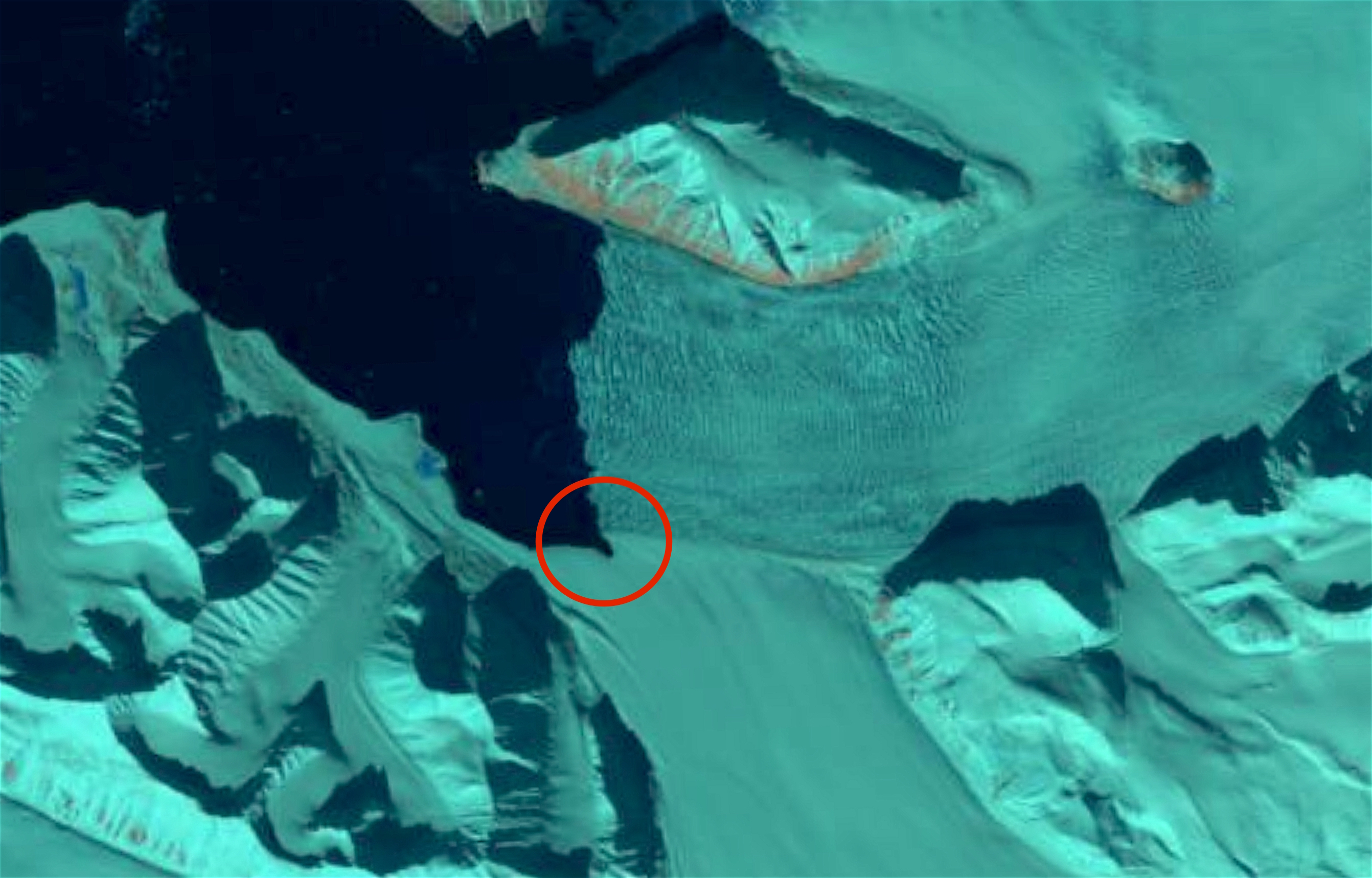
Landsat satellite imagery of Kronebreen and Kongsvegen from April 2016, showing the significant retreat around the glaciers’ conjoining margin which has formed a marked embayment (approx. 200 m deep compared to the rest of the glacier front). Source: USGS Earth Explorer.
Kronebreen is specifically being used for this study because it is at a very unique and interesting phase, distinguished in two aspects:
1. Since the 1900s, Kronebreen has retreated year-on-year. Often the front sits in similar position for a number of years (+/- 100 m in one year) and then rapidly retreats (+/- 1000 m in one year) to a new stable position (Schellenberger et al., 2015). For a number of years now, the front of Kronebreen has been gradually retreating. We have recently observed a marked stretching and thinning of the terminus area which happened over the winter season of 2014. It is also known that the bed on which Kronebreen sits is particularly deep in places just behind the glacier front. The combination of a thin terminus and a sudden change in topography make it vulnerable to another of these rapid retreat periods. Although such retreats have often been documented, highly-detailed observations (e.g. frequent satellite images, time-lapse imagery) are seldom recorded.
2. Kronebreen is adjacent to Kongsvegen, both fed from the same ice field and sharing a lateral margin. Kongsvegen is slower-moving than Kronebreen, with considerably less calving activity. The difference between these two glacier is abundantly clear when looking from above at the presence of crevasses on their surfaces - there is a high density of crevasses on Kronebreen compared to the smooth surface of Kongsvegen. Recently there has been greater calving activity around the mutual margin, forming a marked embayment. This is likely to be the beginning of the separation of these two glaciers. Separations like this have not been documented closely because they happen rarely. With the changing climate though, it is highly probable that similar separations will occur at other glaciers around the world. By studying this one, we may be able to detect the initiation of the separation process in the future. For more on this separation, click here.
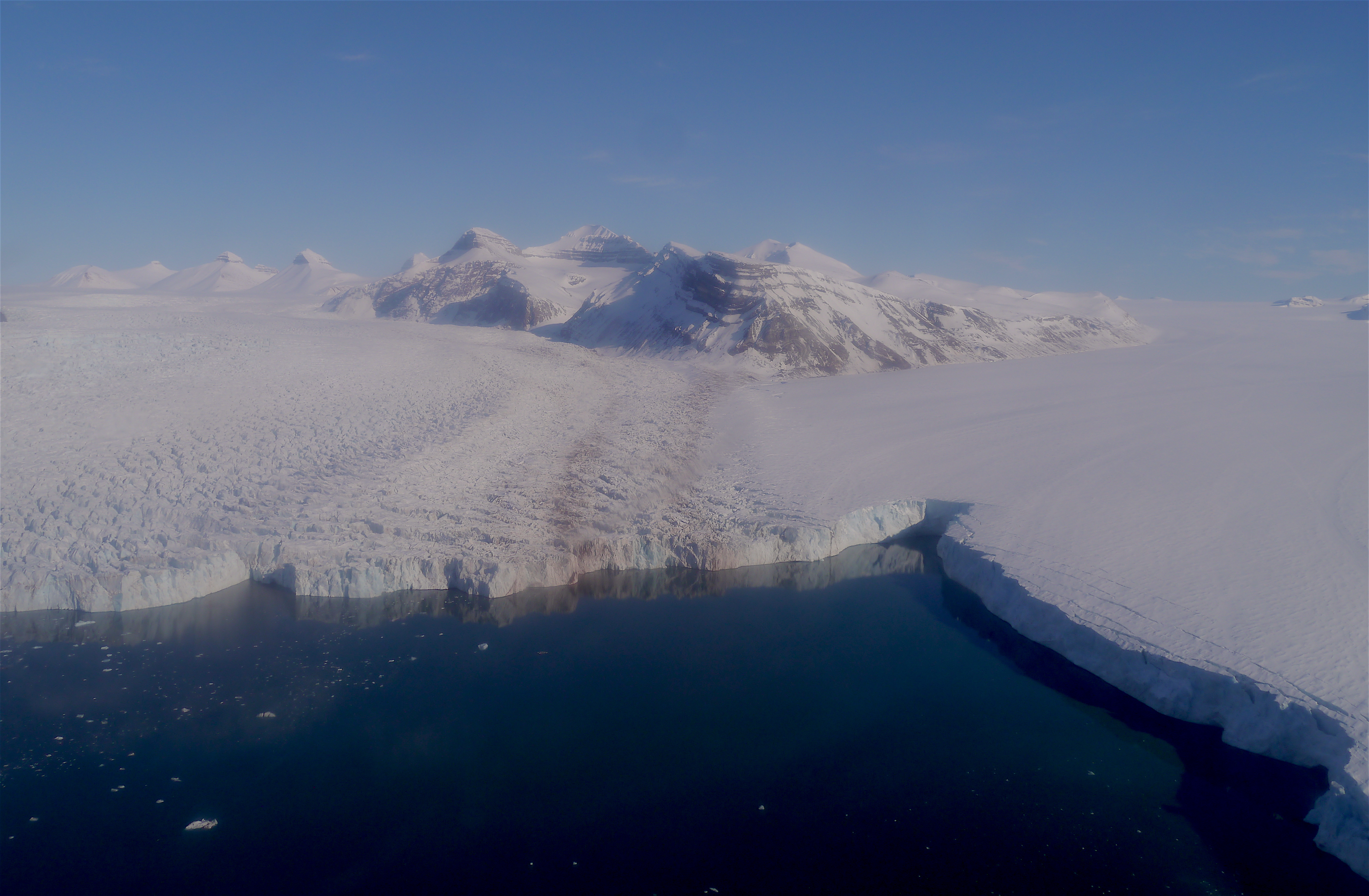
The embayment at the mutual margin between Kronebreen and Kongsvegen (May 2016).
Time-lapse imagery acquisition is our best bet of capturing such important changes at Kronebreen. Not only do the time-lapse images offer effective visualisation of these changes, but they can also be used to extract precise, high-frequency measurements. Information on glacier velocity, calving rate, calving style, plume extent, fjord circulation patterns and surface lake estimation can be collected simultaneously. Results (and hopefully publications) will be coming from our previous years' work soon.
The camera deployment this year would not have been possible without the support of Jack Kohler and the Norsk Polarinstitutt. Thank you Jack.
Further reading
1. This AGU blog post on the initiation of glacier separation by Mauri Pelto is a concise story of the current state of Kronebreen and Kongsvegen (published October 2015).
2. Luckman et al., 2015 is a highly detailed paper on changes in velocity and calving activity at Kronebreen since 2013, in relation to tidal level and ocean temperatures. The paper also draws in other study areas around Svalbard (Tunabreen and Aavatsmarkbreen) and finds confident links between ocean temperatures and the long-term rate of calving. Small calving activity is referred to as "frontal ablation" in an attempt to distinguish it from the large, rare, catastrophic calving styles observed at Greenland and Antarctica. By differentiating the terms, the processes behind them can also be discerned and the influence of one on the other can be better distinguished. This may be a good approach to adopt for future research into calving.
3. Åström et al., 2014 is a great paper that tentatively looks at large calving events in relation to smaller calving events, likening glacier termini to self-organised critical systems which transitions between a state of instability build-up and instability release.
4. Work associated with the time-lapse sequence from Helheim Glacier, Greenland - direct observations of a large buoyant flexure calving event (Murray et al., 2015), changes in glacier surface elevation and basal crevasse propagation before the onset of this kind of calving (James et al., 2015), and modelling buoyant flexure calving (Wagner et al., 2016).
